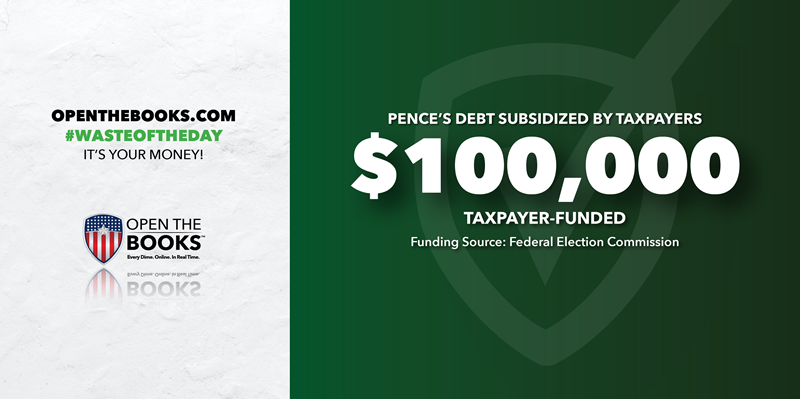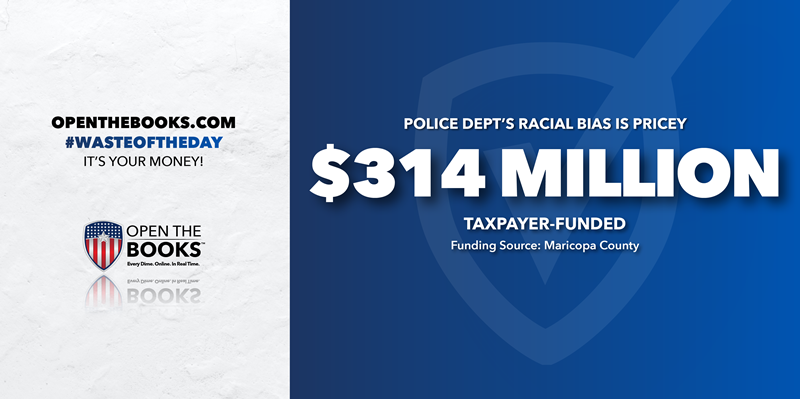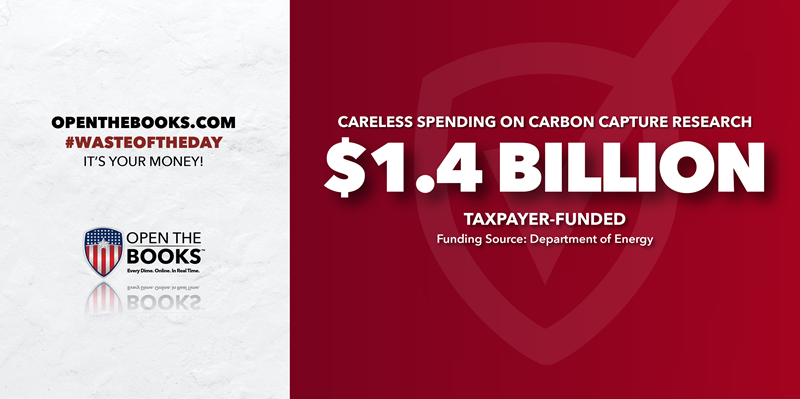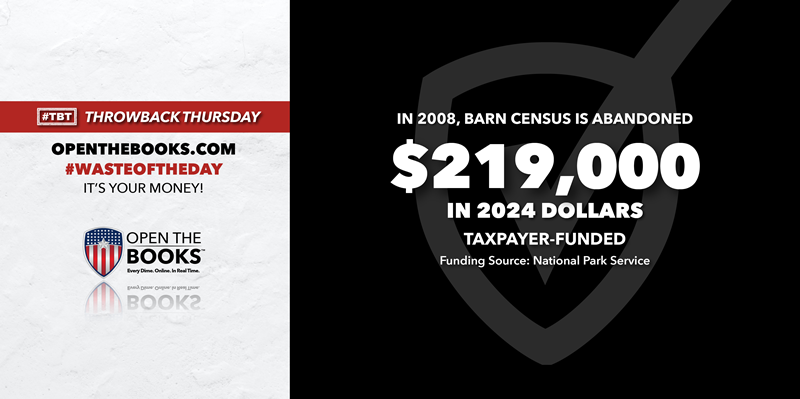
Taxpayers Are Stuck With Former VP’s Campaign Debt
June 17, 2024

Topline: Mike Pence’s failed presidential campaign amassed over $1.3 million in debt, and now he’s forcing taxpayers to help foot the bill.
The Federal Election Commission authorized $100,000 in public matching funds to be paid to Pence from the U.S. Treasury, with more money likely on the way. It’s the first time since 2016 a presidential candidate has used matching funds.
Key facts: Any presidential candidate who raises at least $100,000 from small donations in 20 different states is eligible to have their campaign contributions matched with public money, potentially costing taxpayers millions.
The system used to be more popular but is rarely used today because candidates must agree to spending limits and other restrictions. They can only use $50,000 of their own money and can only spend roughly $200,000 in each state during the primaries.
Pence launched his campaign in June 2023 and raised over $5 million before dropping out in October.
He spent $150,000 of his own money on his campaign but refunded most of it a few weeks before dropping out — presumably to get himself under the $50,000 threshold and make himself eligible for matching funds after his campaign ended, according to the New York Times.
The money, though, is meant to help candidates avoid dropping out of the race, not for paying off debt after the fact. Pence requested the money on Oct. 12 and dropped out on Oct. 28.
Pence has a net worth of about $4 million, per Forbes. His campaign spent over $4.7 million and had $584,000 in cash on hand this March, according to the FEC.
Background: Barack Obama was the first major presidential candidate to reject general election matching funds in 2008, calling the system “broken” and blaming Republicans for taking “millions and millions.” Today, the New York Times says using matching funds is a “sign of desperation.”
The system was last used by Democrat Martin O’Malley and the Green Party’s Jill Stein in 2016. They accepted $1.1 million and $591,000, respectively.
Public matching theoretically amplifies the power of middle-class voters and helps keep wealthy donors from controlling elections. Donations can only be matched up to $250, potentially doubling the impact of a small donation and giving candidates more incentive to cater towards everyday voters.
Summary: Pence’s campaign didn’t make much of an impact on the electoral landscape, but it will leave an impression on taxpayers’ wallets.
Arizona County Police Haven’t Eliminated Racial Profiling
June 18, 2024

Topline: An Arizona police department will soon have spent $314 million in the past 11 years to fix discriminatory practices in its traffic patrols, but the agency is somehow still not compliant with three court orders ordering it to eliminate racial bias, according to the Associated Press.
Key facts: A federal judge ruled in 2013 that the Maricopa County Sheriff Office’s “immigration patrols” systematically targeted Latinos. Police in Arizona’s most populous county were pulling over drivers to check their immigration status without any reason for suspicion aside from the drivers’ race.
U.S. District Court Judge Murray Snow ordered Maricopa County to fix its traffic patrols and, later, its internal affairs unit. It likely could have been an inexpensive, quick process — had the sheriff actually listened.
Snow had already issued an injunction in 2011 to stop the patrols, but the patrols continued until 2013. That led to a criminal conviction and possible jail time until then-President Donald Trump pardoned the sheriff, Joe Arpaio, in 2017.
Arpaio refused to acknowledge wrongdoing by his police department and was later found to have brought racial bias into his internal affairs investigations. His successor, Paul Penzone, was found in civil contempt of court in 2022 for taking too long to close those investigations, leading to yet another court order and more taxpayer spending.
The police department is now mostly compliant with two of the court orders and partially compliant with the 2022 order, according to the Associated Press.
County officials approved spending $41 million this May to make progress, the most expensive allocation yet.
Most of the spending so far has gone toward hiring new employees to meet the court’s requirement of three straight years of compliance. The U.S. district court also appointed staffers to oversee the transition and billed Arizona taxpayers for their cost, according to the Associated Press.
Background: Maricopa County’s current Sheriff Russell Skinner made over $157,000 last year, according to OpenTheBooks.com. Penzone made just over $100,000 in 2022 before he was ousted.
Arpaio lost reelection as sheriff in 2017 but is currently running for mayor of Fountain Hills, a wealthy suburb in the county. He lost by just 213 votes in 2022. His 92nd birthday is this month.
Summary: Maricopa County can’t get its act together even with $314 million in extra taxpayer money.
Department of Energy Is Irresponsible with Grant Money
June 19, 2024

Topline: The Department of Energy spent $1.4 billion to fund 654 carbon capture research projects from 2018 to 2023, but some were risky and might have been scientifically impossible, according to the Government Accountability Office.
Key facts: President Joe Biden’s Bipartisan Infrastructure Law has already set aside $12 billion for carbon capture research — the process of removing carbon dioxide from the atmosphere to help stop global warming — but auditors say there’s no guarantee that “taxpayer dollars are going towards selected projects that are more likely to succeed.”
The DOE performs “risk screenings” before awarding grants to determine if scientific experiments are logical and have enough money to succeed. Auditors found several instances where DOE officials identified issues during a project’s risk screening but awarded them grants anyway.
One grant recipient did not have a strong plan to address how Covid-19 would impact its schedule. Another was known to be at risk of duplicating its own efforts.
The DOE said the risks were resolved before grants were awarded but could not provide documentation to back up that claim.
The DOE also scores potential grant recipients on the scientific plausibility of their work, but $14.6 million was paid to a project that did not meet the DOE’s own standards. Researchers did not check to see if it was even possible to store carbon at their proposed location.
The project is now $5.1 million over budget and over a year behind schedule.
Auditors also said the DOE did not enforce requirements for grant recipients to review and report the risks of their work every three months.
Auditors reviewed 40 of the 654 projects. They concluded that the DOE “engaged in some practices that could expose taxpayer funds to the risk of funding unsuccessful projects and undermine the likelihood of project success.”
Background: Some companies hope that carbon capture will allow them to keep using fossil fuels, but only 45 million tons of carbon are captured each year. Scientists estimate the world would need to capture 32 billion tons to limit the effects of global warming.
Dr. Faith Birol, head of the International Energy Agency, says that solving global warming “means letting go of the illusion that implausibly large amounts of carbon capture are the solution."
When President Joe Biden announced funding for carbon capture projects last year, Basav Sen of the Institute for Policy Studies told the Associated Press that “We are headed towards global catastrophe, and do not have the luxury of time or resources to squander on speculative solutions such as [carbon capture].”
Summary: Not only is the DOE careless when awarding grants, but it is funding research that can’t possible work at the scale necessary to help combat climate change.
Throwback Thursday: Vermont Counts Its Chickens
June 20, 2024

Throwback Thursday!
Topline: There are plenty of proven methods for conducting demographic surveys. Questionnaires and systematic census interviews work just fine.
Asking Americans to run around Vermont and count the number of barns in the state seems a bit less effective, but that’s what the National Park Service decided to spend $150,000 on in 2008. The money would be worth nearly $219,000 today.
That’s according to the “Wastebook” reporting published by the late U.S. Senator Dr. Tom Coburn. For years, these reports shined a white-hot spotlight on federal frauds and taxpayer abuses.
Coburn, the legendary U.S. Senator from Oklahoma, earned the nickname "Dr. No" by stopping thousands of pork-barrel projects using the Senate rules. Projects that he couldn't stop, Coburn included in his oversight reports.
Coburn's Wastebook 2008 included 65 examples of outrageous spending worth more than $1.3 billion, including the $150,000 for Vermont’s barn census.
Key facts: The Vermont Division for Historic Preservation launched the “barn census” in the hopes of collecting pictures of and stories about every barn in the state.
Challenges quickly arose, as reported by the Bennington Banner, even though the state provided “workshops on barn census taking” for volunteers.
Some barn owners didn’t allow census takers onto their property or simply weren’t home. Others spoke endlessly about their barn’s history, taking up hours of volunteers’ time.
Census takers also said there were few reliable methods for determining a barn’s age “aside from it simply looking old.”
The photo records are even more amusing. One graduate student at the University of Vermont participated in the census as part of her coursework and needed the help of 12 classmates to snap a photo titled “That’s A Barn!” The picture is, in fact, of a barn.
The census continued sporadically for 11 years until 2019, at which point it had documented only 2,800 of the estimated 10,000 historical barns in Vermont.
Summary: At least counting chickens before they’re hatched is free. Why should it cost $150,000 to count barns?
Newsom Wants Stronghold Over California Taxes
June 21, 2024

Topline: California voters may soon have a more direct voice in approving their sky-high tax rates — unless Gov. Gavin Newsom and other top Democratic lawmakers have something to say about it.
Newsom’s attorneys are asking the state Supreme Court to remove an upcoming ballot measure that would require new taxes to be approved by voters, not just lawmakers.
Key facts: The proposed Taxpayer Protection and Government Accountability Act would stop new state taxes from being enacted without support from two thirds of the Legislature and a majority of voters. New local taxes would need approval from two thirds of city voters.
Democrats hold supermajorities in both houses of the California Legislature. Top politicians are backed by labor unions and big-city mayors in their effort to stop the ballot measure, according to Politico. Their attorneys say the proposal unconstitutionally removes elected officials’ ability to raise revenue.
The campaign in support of the ballot measure is funded mostly by real estate moguls and the California Business Roundtable, which brings together executives from the largest employers in the state.
The CA Supreme Court heard arguments in May, but Politico reports that justices seem willing to let the measure go to voters in November and then rule on its constitutionality if it passes.
California collected $280.8 billion in taxes in 2022, more than double any other state. That’s $7,195 per person, also the most in the nation.
Background: OpenTheBooks has spent years covering the questionable Newsom and his conflicts of interest or wasteful spending.
It took OpenTheBooks.com ten years to force open the California state checkbook. Then, we found that Gov. Newsom solicited up to 1,000 state vendors, their key employees and executives, for $10.6 million in campaign donations. Those companies received $6.2 billion in state payments during FY2021.
Newsom’s administration also sent $2.3 million to Gender Spectrum, a nonprofit that supports kindergarten students’ “gender journey” and encourages students to invent their own gender.
Critical quote: Carolyn Coleman, CEO of the League of California Cities, told the Associated Press that the ballot measure puts 100 local taxes worth over $2 billion at risk.
“We’re raising the resources to fill potholes, so that we can support affordable housing in our community, so we can work to address homelessness, so that when you dial 911 there’s somebody there to answer the phone — not in two minutes — but in 30 seconds,” Coleman said.
Supporting quote: Lawyers supporting the ballot measure told justices, “Our constitution, since its inception, has stated that all political power is inherent in the people. It has stated that the people have the power to reform and alter their government whenever they decide it needs reform … The people have the last word.”
Summary: America was founded on the with three important word, “We The People...” California must allow that to happen.
The #WasteOfTheDay is presented by the forensic auditors at OpenTheBooks.com.